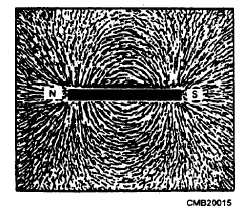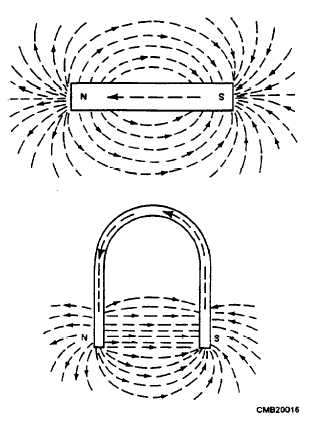(fig. 1-15). These curved lines, extend from the two poles of the magnet, follow the magnetic lines of force surrounding the magnet. Lines of force rules are as follows:
The lines of force (outside the magnet) pass from the North Pole to the South Pole of the magnet.
The lines of force act somewhat as rubber bands and try to shorten to minimum length.
The lines of force repel each other along their entire length and try to push each other apart.
The rubber band characteristic opposes the push-apart characteristic.
The lines of force never cross each other.
The magnetic lines of force, taken together, are referred to as the magnetic field of the magnet.
The magnetic fields of a bar and of a horseshoe magnet are shown in figure 1-16. In each, note how the lines of force curve and pass from the North Pole to the South Pole.
Effects between magnetic poles (fig. 1-17). When two UNLIKE magnetic poles are brought together, they attract. But when LIKE magnetic poles are brought together, they repel. These actions can be explained in terms of the rubber band and the push- apart characteristics. When unlike poles are brought close to each other, the magnetic lines of force pass from the North Pole to the South Pole. They try to shorten (like rubber bands) and, therefore, try to pull the two poles together. On the other hand, if like poles are brought close to each other, lines of force going in the same direction are brought near each other. Because these lines of force attempt to push apart, a repelling effect results between the like poles.
ELECTROMAGNETISM
An electric current (flow of electrons) always creates a magnetic field. In the wire shown in figure 1-18, current flow causes lines of force to circle the wire. It is thought that these lines of force result from the movement of the electrons along the wire. As they move, the electrons send out the lines of force. When many electrons move, there are many lines of force (the magnetic field is strong). Few electrons in motion means a weak magnetic field or few lines of force.
Electron movement as the basis of magnetism in bar and horseshoe magnets can be explained by assuming that the atoms of iron are so lined up in the magnets that the electrons are circling in the same direction and their individual magnetic lines of force add to produce the magnetic field.
The magnetic field is produced by current flowing in a single loop of wire (fig. 1-19). The magnetic lines of force circle the wire, but here they must follow the

Figure 1-15. - Magnetic lines of force.

Figure 1-16. - Bar and horseshoe magnet.
Continue Reading